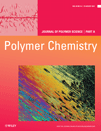Well-defined succinylated chitosan-O-poly(oligo(ethylene glycol)methacrylate) for pH-reversible shielding of cationic nanocarriers
Abstract
A novel type of well-defined graft copolymer, succinylated chitosan-O-poly(oligo(ethylene glycol)methacrylate) (SC-POEGMA), was developed for pH-reversible poly(ethylene glyocol) (PEG) shielding of cationic nanocarriers. Chitosan-O-POEGMA (CS-POEGMA) was first synthesized via single electron transfer-living radical polymerization of oligo(ethylene glyol) methacrylate (OEGMA) using O-brominated chitosan (CS-Br) as a macromolecular initiator and Cu(I)Br/1,1,4,7,10,10-hexamethyltriethylenetetramine as a catalyst. The subsequent succinylation of the chitosan backbone gave the titled copolymers. The content of POEGMA in CS-POEGMA could be widely modulated by varying the degree of bromination and feed ratio of OEGMA to CS-Br, without compromising the amino density of chitosan backbone. The hierarchical assembly between SC-POEGMA and trimethylated chitosan-O-poly(ε-caprolactone) (TMC-PCL) micelles was further studied. At pH 7.4, the stoichiometric interactions between SC and TMC segments to form polyampholyte–polyelectrolyte complexes led to the formation of PEG-shielded micelles. The hierarchially assembled micelles could be disassembled into the pristine TMC-PCL micelles, when the medium pH was below a certain pH (pHφ). By varying the degree of succinylation of SC-POEGMA, the pHφ value could be facilely modulated from 6.5 to 3.5 to meet the needs for specific biomedical applications. © 2011 Wiley Periodicals, Inc. J Polym Sci Part A: Polym Chem, 2011




